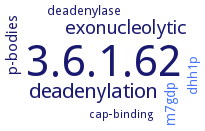3.6.1.62: 5'-(N7-methylguanosine 5'-triphospho)-[mRNA] hydrolase
This is an abbreviated version!
For detailed information about 5'-(N7-methylguanosine 5'-triphospho)-[mRNA] hydrolase, go to the full flat file.

Reaction
Synonyms
D10 decapping enzyme, D10 protein, D9 protein, Dcp1p, Dcp2, Dcp2p, decapping nudix hydrolase, EC 3.6.1.30, H29K, hDcp2, hNUDT16, mRNA decapping enzyme, mRNA decapping enzyme D10, mRNA decapping enzyme D9, Nudt16, Nudt17, Nudt19, Nudt20, NUDT3, U8 snoRNA binding protein, X29, X29 protein
ECTree
Advanced search results
Engineering
Engineering on EC 3.6.1.62 - 5'-(N7-methylguanosine 5'-triphospho)-[mRNA] hydrolase
Please wait a moment until all data is loaded. This message will disappear when all data is loaded.
A22V
the differences in the kinetic parameters caused by the A22V mutation are small (less than a factor 2)
E76Q
-
mutation totally abolishes the decapping activity under the standard assaying condition
E80Q
-
mutation totally abolishes the decapping activity under the standard assaying condition
E153Q
mutant has 3 molecules in the asymmetric unit. There is clear electron density for an octahedrally coordinated Mg2+ in the structure, similar to wild-type. Mutant is severely catalytically compromised and displays a linear dependence on pH over the range studied (pH 79.5)
E198Q
mutant lacks clear density for a metal ion in the active site and fails to crystallize in the presence of any divalent cation
W50A
Mutation in subunit Dcp2. While the wild-type Dcp1-Dcp2 complex is stimulated by enhancer of decapping Edc1CTR by a factor of 13, it only enhances catalysis in the W50A mutant by a factor of three. Coactivation of decapping by Dcp2 is linked to formation of the composite active site
W43A
E132A
-
7.8% of wild-type activity. The E132A mutant shows a 5fold reduced affinity for Mg2+, but retains a Mn2+ affinity similar to that of the wild type
E141A
-
10% of wild-type activity. The E141A mutant demonstrates only slight variations in both Mg2+ and Mn2+ binding
E145A
-
12.2% of wild-type activity. the E145A mutant shows 2-fold reduced affinity for Mg2+ and 6-fold reduced Mn2+ binding
E92Q
mutant displays weak decapping activity under the standard decapping conditions in both Mg2+ and Mn2+, a significant increase in hydrolysis in the presence of higher concentrations of metal
E92Q/E93Q
mutation displays less than 5% decapping activity in Mn2+ under the optimized decapping conditions. A 10fold increase in the amount of metal present in the reaction (to 1 mM Mn2+) only marginally increases the efficiency of cap hydrolysis
E93Q
mutation displays less than 5% decapping activity in Mn2+ under the optimized decapping conditions. A 10fold increase in the amount of metal present in the reaction (to 1 mM Mn2+) only marginally increases the efficiency of cap hydrolysis
additional information
-
decapping actiovity is abolished by point mutations in the Nudix hydrolase motif
mutation at Trp43 blocks kinetic stimulation by subunit Dcp1
W43A
-
mutation at Trp43 blocks kinetic stimulation by subunit Dcp1
-


 results (
results ( results (
results ( top
top






